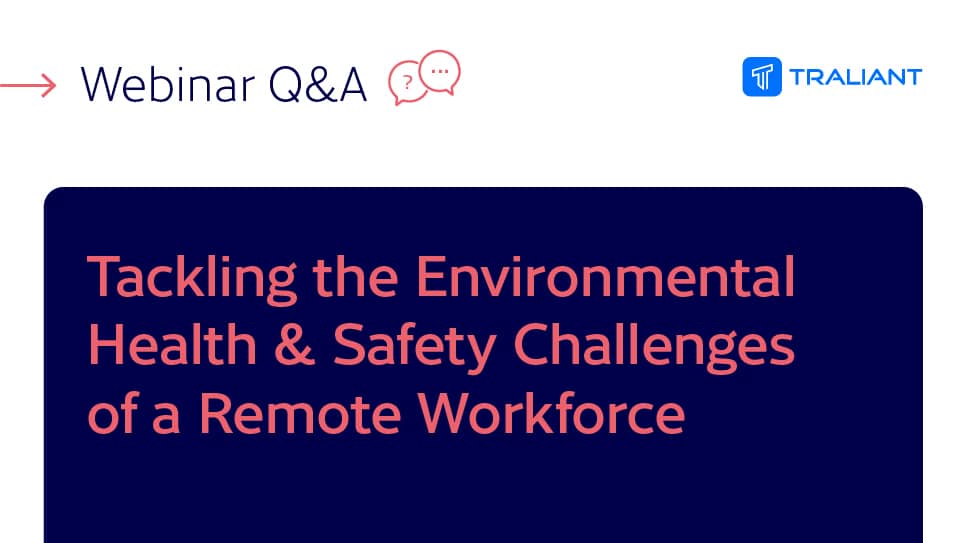
Understanding and Preventing Quid Pro Quo Harassment in the Workplace
Harassment Prevention


There are many reasons to provide a health and wellness program. Perhaps none are more important than demonstrating to employees that you value their well-being and want them to thrive. By promoting a positive and empathetic culture, organizations enhance their brand reputation and image as a great place to work. Traliant Training Making health and […]

With more than 27 million Americans working from home, coffee shops and other remote location at least one day per week, employers face unique challenges ensuring the environmental health and safety (EHS) of employees. To help companies protect employees and remain compliant with the expectations of the Occupational Health and Safety Administration (OSHA) to provide a safe workplace that is free from serious hazards, Traliant sponsored a May 4 webinar entitled: “Tackling the Environmental Health & Safety Challenges of a Remote Workforce.”
During the 30-minute event, Traliant’s Andrea Foster-Mack, Product Director of Environmental Health and Safety, shared practical steps to meet today’s safety challenges based on her 17 years of combined EHS experience and her relationships with the Department of Labor, OSHA, Centers for Disease Control and Prevention (CDC) & US Senate/House subcommittees. She also announced Traliant’s release of a comprehensive EHS compliance training library.
Below are some of the questions Andrea addressed during the webinar.
Remote employees often work longer hours when officing from home. What recommendations do you have for creating a better work-life balance?
By implementing these tips, you can achieve a better work-life balance to avoid stress and burnout.
Are there other EHS considerations or best practices a global workforce should take into account (requirements beyond OSHA)?
Yes, companies with a global workforce should be aware of the laws and regulations in each country they operate in, as they may differ from those in the US. For example, some countries may have stricter rules regarding working hours, breaks and rest periods. Additionally, it’s important for companies to establish clear communication channels and cultural awareness training to ensure that all employees feel included and valued. Providing resources and support for mental health and well-being can also help global workers feel more connected and engaged. Safety and health training that is focused on hazard awareness and in individuals’ native language helps ensure employees understand hazard avoidance strategies and risk mitigation techniques.
Does OSHA differentiate between types of “remote” work? For example, working from home versus working from anywhere such as a coffee shop?
There is no distinction made by OSHA between remote work and work from home. The OSH Act applies to work performed by an employee in any workplace within the US, including a workplace located in the employee’s home or at a local coffee shop. Employers must ensure that their employees’ work environments are safe and that they are protected from hazards that could occur during their at-home employment. You can help protect your employees by having them complete a Job Hazard Analysis (JHA) for these environments, as well as participate in general hazard awareness training like ergonomics, housekeeping, preventing workplace violence, and slips, trips and falls.
What are some of the issues employees can encounter when working remotely at a local coffee shop, and how does the liability get split between the shop and the organization?
Working from a local coffee shop like Starbucks can subject employees to potential hazards.
If an employee is working remotely from a coffee shop, liability for any accidents or injuries would be based on a case-by-case basis and would be determined by the type of injury or accident that occurred, as well as how the accident or injury occurred.
It is important for organizations to have clear policies, guidelines and training in place for remote workers, including providing hazard awareness training, providing safety checklists based on OSHA regulations for work performed in any workplace (remote/ hybrid/on-site) within the US and having employees complete a JHA. Additionally, organizations should support health and wellness and champion mental health support by regularly checking in to ensure the well-being of employees working remotely.
Click here to listen to an on-demand replay of Traliant’s webinar “Tackling the Environmental Health & Safety Challenges of a Remote Workforce.”
Keep your employees safe on the job with Traliant’s Environmental Health and Safety library of compliance training. Click here for a free course trial.